-
03
-
03
-
03
-
03
-
03
-
03
-
03
-
03
-
03
-
03
-
03
-
03
-
03
-
03
-
03
-
03
-
03
-
-
-
03
-
03
-
03
-
03
-
03
-
03
-
03
-
03
-
-
03
-
03
-
03
-
03
-
03
-
-
03
-
03
-
03
-
03
-
-
03
Illuminations of the Art Songs of Margaret Allison Bonds (1913-1972)
Monday, August 24, 2020
Posted By:Alethea N. Kilgore, Associate Professor of Vocal Studies at Florida A & M University
—
Introduction
Margaret Allison Bonds, a concert pianist and music educator, composed between 1932 and 1972. Bonds not only composed in the large forms of the early twentieth century (symphony, ballet, and oratorio), but also gained success as a composer of solo piano and vocal works. Her solo vocal repertoire consists of approximately one hundred compositions composed in a variety of styles: art songs, spirituals, musical theatre songs, popular songs, and jazz songs. There are two attributes that all of her solo vocal compositions share: the incorporation of American poetry, including literature from the Harlem Renaissance, and the musical characteristics found in one of the few types of indigenous American music: jazz. It is no wonder that the poetry of her lifelong friend, Langston Hughes (1902-1967), one of the pre-eminent writers of the Harlem Renaissance and the father of “jazz poetry,” inspired over half of her solo vocal compositions. Bonds not only composed incidental music for several of Hughes’s theatrical works, but also used his poetry in her art songs, popular songs, and oratorios.
Hughes’s poems have been set by nearly sixty composers, producing over 200 songs, and the mere titles of his poems arouse musical interest. His poems include, “The Weary Blues,” “Song for a Banjo Dance,” “Nocturne for the Drums,” “Spirituals,” “Harlem Night Song,” “The New Cabaret Girl,” “Ballad of Booker T.” and “Minstrel Man,” which was set by Margaret Bonds in 1955.
Although Bonds never set Hughes’s “Ballad of Booker T.” to music, the draft of this poem, written in 1941 and shown in Figure 1.1, displays the unique lyricism and rhythmic continuity often found within Hughes’s poetry. Similar to Margaret Bonds, Langston Hughes was an advocate for the advancement of African American people, culture, literary and performing arts. Hughes’s poem “Ballad of Booker T.,” promulgates the philosophy of Booker T. Washington (1856-1915) who strongly supported higher education for African Americans, specifically within the vocational arts medium. Booker T. Washington was the founder of Tuskegee Institute (1881) and the National Negro Business League (1900). It is interesting to note that in 1908, Dr. Monroe Alpheus Majors, Margaret Allison Bonds’s father, accepted a three-year term as editor of the Chicago Conservator at the request of Booker T. Washington. [1]
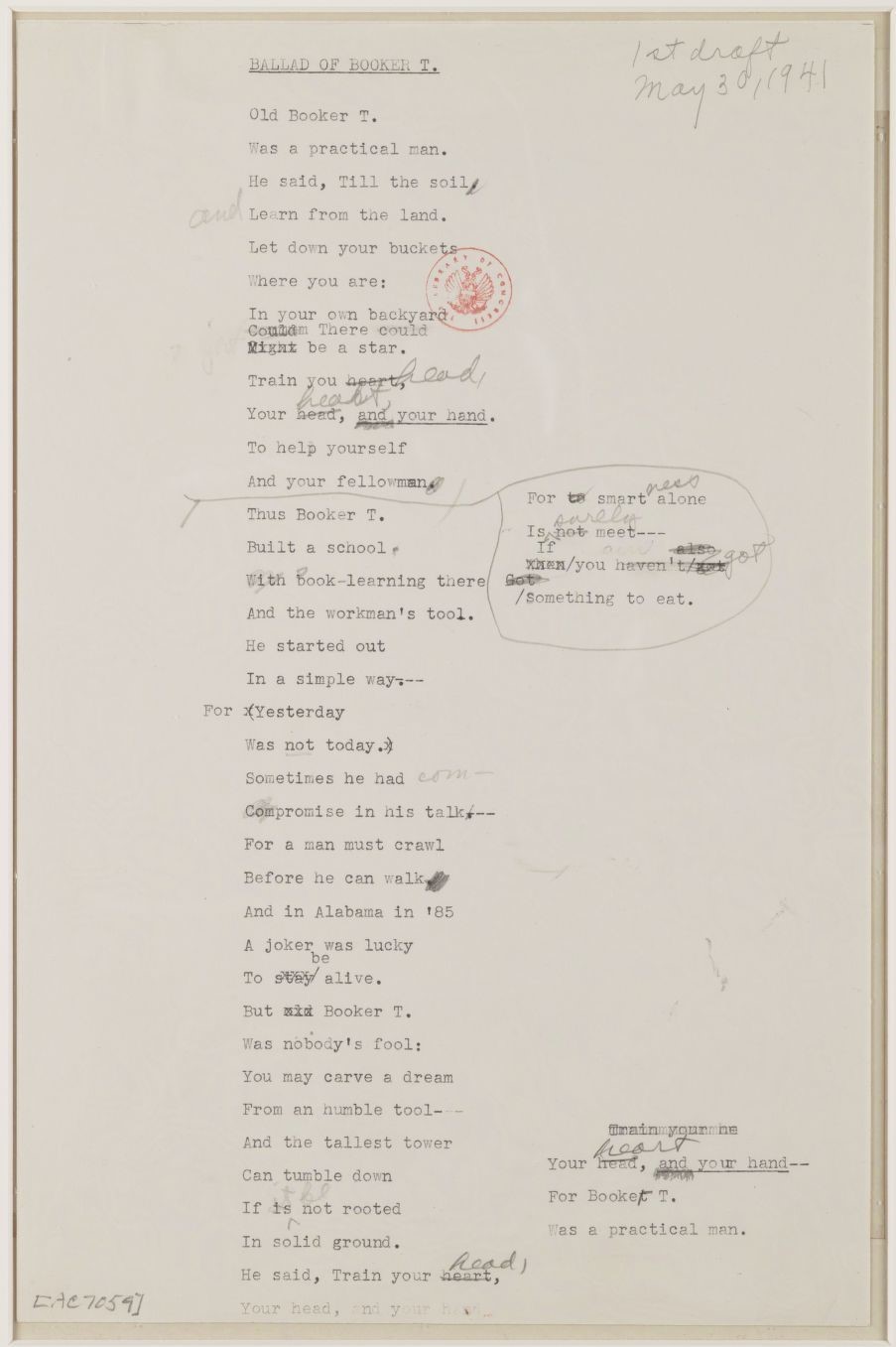
Fig. 1.1 Drafts of Langston Hughes’s poem “Ballad of Booker T.,” 30 May-1 June 1941 [2]
One of the most distinctive aspects of Bonds’s musical style is her incorporation of musical elements drawn from African American genres. Bonds connected elements drawn from African American folksongs, ragtime, and the blues. These characteristics include modal melodies, pentatonic scales, polyrhythms between the vocal line and piano accompaniment, syncopations, and pitches drawn from blues inflections. Bonds often implemented jazz harmonies and incorporated shifts between major and minor keys or major-modal, and/or pentatonic passages in order to embellish the text. Following in the footsteps of Harry T. Burleigh and Florence Price, Bonds successfully assimilated African American musical idioms with compositional techniques derived from the classical idiom. This amalgam of African American and European musical traditions makes her repertoire distinct within American song literature. Bonds also played a significant role in assisting with the development of the concert setting of the African American spiritual.
The Art Songs: An Overview
Bonds’s art songs are characterized by melodies that are often entrenched with beautiful lyricism and a robust connection between text and music. She held a general preference for syllabic text settings, and often used localized text painting. The piano is also a significant component of her art songs. The vocal line and piano accompaniment move independently of one another and nearly every song includes a piano introduction that introduces musical motives or thematic material. These piano preludes often seem to establish an important poetic idea or mood found within the song, permitting the piano to play a role in the dramatic action. The harmonies in her accompaniments are at times inspired by jazz and impressionist composition. Quartal chords and extended tertian harmonies such as seventh, ninth, eleventh, and thirteenth chords also appear frequently in her art songs. Her art songs often shift between major and minor keys or major-modal, and/or pentatonic passages in an effort to reflect the text.
The art songs of Margaret Allison Bonds can be separated into three periods: early (1932-1938), middle (1939- 1959), and late (1960-1968) with specific traits that distinguish each period. The early songs (1932-1938) are highly influenced by musical elements drawn from African American folk songs and the blues. They are mostly in minor keys and often contain modal melodies. The middle songs (1939-1959) display more advanced piano accompaniments and contain vocal lines more suitable for advanced singers. There are several distinct musical characteristics that define the post-1960 songs. A much greater emphasis on chromaticism and non-resolving dissonance is found in these later songs. Shifting and irregular meters create tension and moments of surprise, while providing important word or syllabic emphasis. Whole tone and octatonic scales embellish the text or indicate a change of mood or poetic idea.
Songs of the Seasons
Bonds compiled her second song cycle, Songs of the Seasons, for a commission arranged by tenor Lawrence Watson in 1955. This cycle included “Poème d’automne” and “Winter Moon,” composed in 1934 and 1936 respectively, along with “Young Love in Spring” and “Summer Storm,” composed in 1955. The premiere of this cycle was performed by Watson on March 25, 1956, at Town Hall.
Since the first known art songs composed by Margaret Bonds (“Sea Ghost” and “Sleep Song” composed in 1932, and the first version of “To a Brown Girl, Dead” composed in 1933) have not been located, “Poème d’automne” is the earliest known extant art song. The premiere of “Poème d’automne” took place over twenty years prior to the premiere of Songs of the Seasons, on April 15, 1934, at the Abraham Lincoln Centre in Chicago. This performance was sung by baritone John Greene, accompanied by Mary Catherine Collins. Margaret Bonds also performed on this concert as a solo pianist playing Robert Schumann’s Papillons suite, and Maurice Ravel’s Jeux d’Eaux.n [3]
Bonds assigned a different key signature to each song. “Young Love in Spring” and “Summer Storm” are in major keys, while “Poème d’automne” and “Winter Moon” are in minor keys with each key signature serving to symbolize the poetic ideals associated with each season.
Poème d’automne
“Poème d’automne,” composed by Bonds at age twenty-one, provides an early example of her gift for composing art songs. Already, Bonds had a keen understanding of compositional style and showed excellent skill in writing counterpoint. “Poème d’automne” is set in common time, in the key of C minor with a brief modulation to G major that occurs between mm. 18–22. The form is through-composed. This song begins with a short piano prelude that not only sets the sultry mood of this song, but presents the thematic material found throughout the piano accompaniment. This thematic material can be seen in m. 1 of Example 1.1. It is comprised of a C-minor-ninth chord set to a syncopated, polyrhythmic motive that Bonds wove throughout the song.
The vocal line is comprised of medium length, arpeggiated phrases with a predominantly syllabic setting of the text. The first five measures of the vocal line are based on the blues scale C–E-flat–F–G-flat–G–B-flat–C. Bonds used these blue notes (flatted thirds, flatted fifths, and flatted sevenths) in the vocal line, as well as diminished fourths found in the top line of the piano in mm. 4–5 (D–G-flat) to create a rich, warm tone color that illustrates the colors of the autumn leaves (see Example 1.1). The minor-ninth chords (C–E-flat–G–B-flat–D) found in the first three measures of the piano also aid in establishing this minor sonority.
Bonds uses text painting through a descending melodic passage that illustrates the word “heavy” and the blue note G-flat, to emphasize the word “color” as seen in the vocal line of m. 4 in Example 1.1.
Ex. 1.1: “Poème d’automne,” from Songs of the Seasons, mm. 1–5.
Unpublished manuscript obtained from Dr. Louise Toppin.
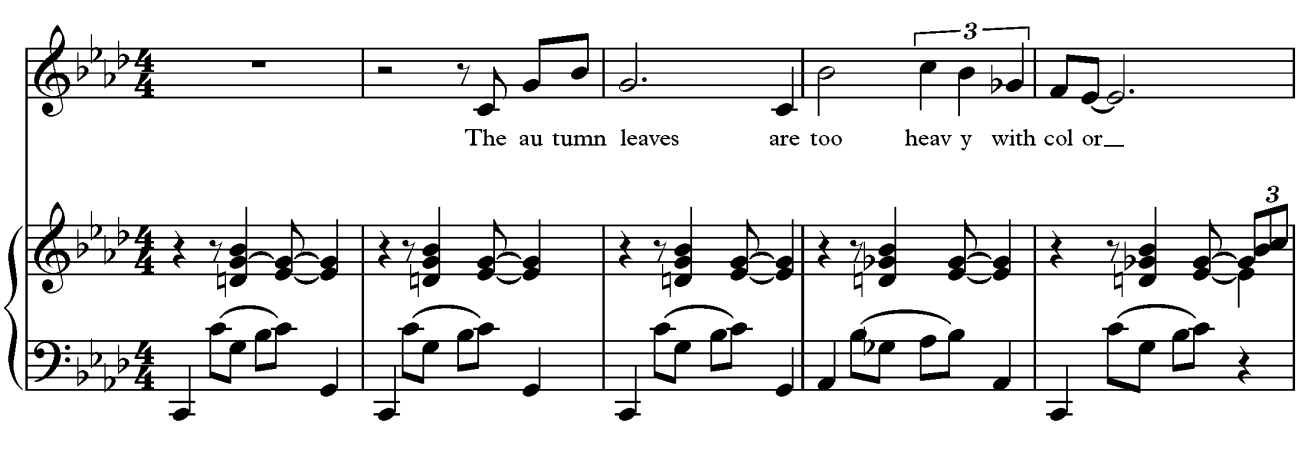
Bonds ended “Poème d’automne” with a C-minor-ninth chord. The ninth of the chord D5, is sustained in the vocal line for five measures. The range for “Poème d’automne” is C4 to A5, making it suitable for medium voices.
Winter Moon
“Winter Moon” is the shortest song in the cycle and is comprised of only fourteen measures. Bonds set this song in common time, in a through-composed form, in the key of F minor. The two-bar introduction participates in setting the mood of the song and presents a recurring musical motive. This motive is comprised of an ostinato, coupled with two recurring half-notes that illustrate the shimmering moonlight. An exact repetition of this motive can be seen in mm. 12–13 in Example 1.2. The vocal line consists of long, sustained phrases and a predominantly stepwise melody that illustrates the thin and slim curved crook of the moon. The last phrase of “Winter Moon” consists of eight repetitions of the tonic pitch that appear in the vocal line (see Example 1.2) giving the impression that the moon is suspended in the air. Here, Bonds also placed open fifths in the top voice of the bass of the piano to create a chilling atmosphere and haunting mood for the end of this song (see Example 1.2). The range for “Winter Moon” is F4 to E-flat 5 and is suitable for most voice types.
Ex. 1.2: “Winter Moon,” from Songs of the Seasons, mm. 11–14.
Unpublished manuscript obtained from Dr. Louise Toppin.
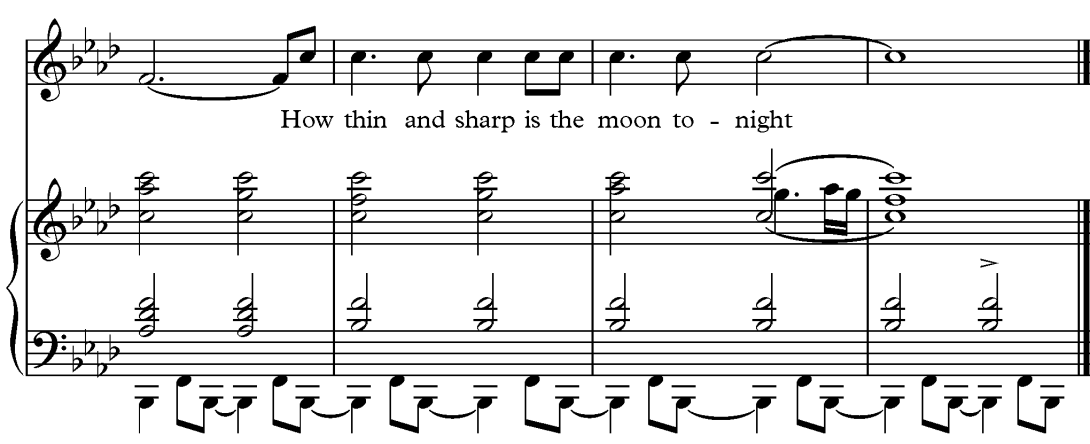
Young Love in Spring
“Young Love in Spring” is in modified strophic form in the key of G major, with a harmonic structure that consists primarily of quartal chords coupled with triplet rhythms and some chromatic inflections in the piano accompaniment. Throughout this song, Bonds showed her mastery in demonstrating poetic ideas. Bonds shifted from the minor keys found in “Winter Moon” and “Poème d’automne” to a major key to achieve a bright and cheerful sonority. She also placed the melody and chords found in the treble of the piano accompaniment in the fifth and sixth octave to create a brilliant tone color that reflects the mood of “Young Love in Spring.” The thematic music found in the six-bar piano introduction also reflects the ideals of this season. Bonds used long, lilting phrases comprised of triplets and polyrhythmic textures as seen in mm. 1–5 in Example 1.3 to arouse the awakening of spring.
The vocal line enters in m. 6 with long, sweeping phrases that often encompass a wide range (see Example 1.3).
Ex. 1.3: “Young Love in Spring,” from Songs of the Seasons, mm. 1–9.
Unpublished manuscript obtained from Dr. Louise Toppin.
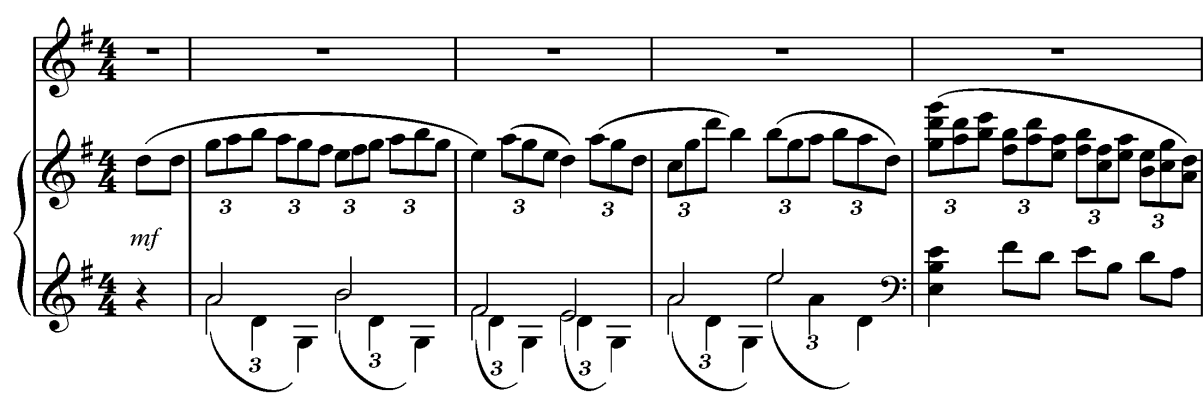
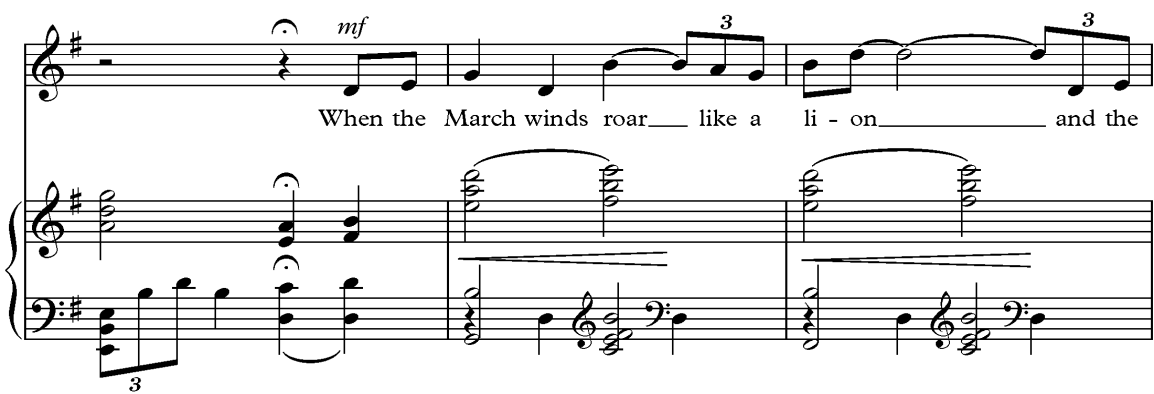
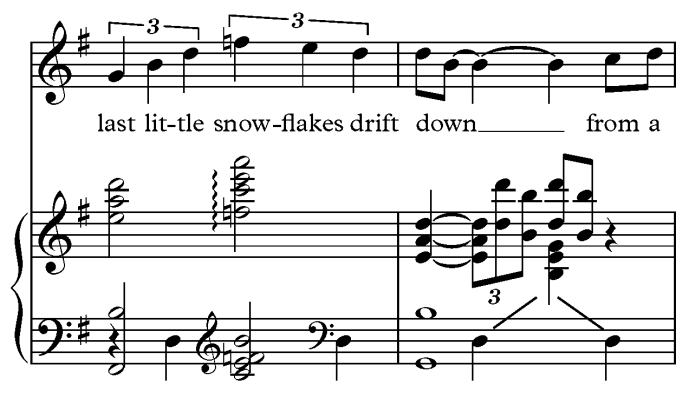
An example of text illustration occurs in m. 10 at “the last little snowflakes drift down,” where Bonds set the word “down” to a rhythmic figure that descends by a minor-third as seen in Example 1.3. A second example can be seen in m. 28 where Bonds used a similar rhythmic figure to set the word “upward,” which ascends by a minor sixth, as seen in Example 1.4. Many other examples of intentional treatment of text are found throughout the score.
Ex. 1.4: “Young Love in Spring,” from Songs of the Seasons, m. 28.
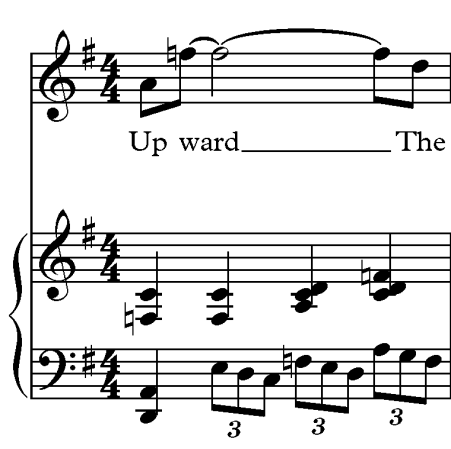
The range of “Young Love in Spring” is D4 to B5 and the tessitura is consistently high. This song is ideal for high voices.
Summer Storm
“Summer Storm,” the last song in the cycle, is 109 measures long. It is the longest song in the cycle and is by far Bonds's longest song composition. The form is A-A'-B-C-D-A''. The first four bars are comprised of an introduction that immediately establishes the stirring atmosphere of the summer storm. Bonds used chromaticism and agitated rhythms to emulate the sound of thunder (see Example 6.9). Although the key signature alludes to C major, the pitches found in the piano accompaniment comprise the blues scale C–D-sharp–F–F-sharp–G–A-sharp–C (see Example 1.5). Bonds used a flatted , , and , to create a bluesy sonority that evokes the humid atmosphere and sultry mood of the season. The vocal line, comprised of a predominantly syllabic setting of the text, enters in m. 5. The pitches found in the melody of the first eight bars of the vocal line make up the blues major pentatonic scale G–A–C–D–E (see Example 1.5). This is a five-note scale comprised of three whole steps and one minor third that occurs between and . Here, Bonds set the text to jazzy, syncopated rhythms that also imitate the sound of the thunder.
Ex. 1.5: “Summer Storm,” from Songs of the Seasons, mm. 1–8.
Unpublished manuscript obtained from Dr. Louise Toppin.
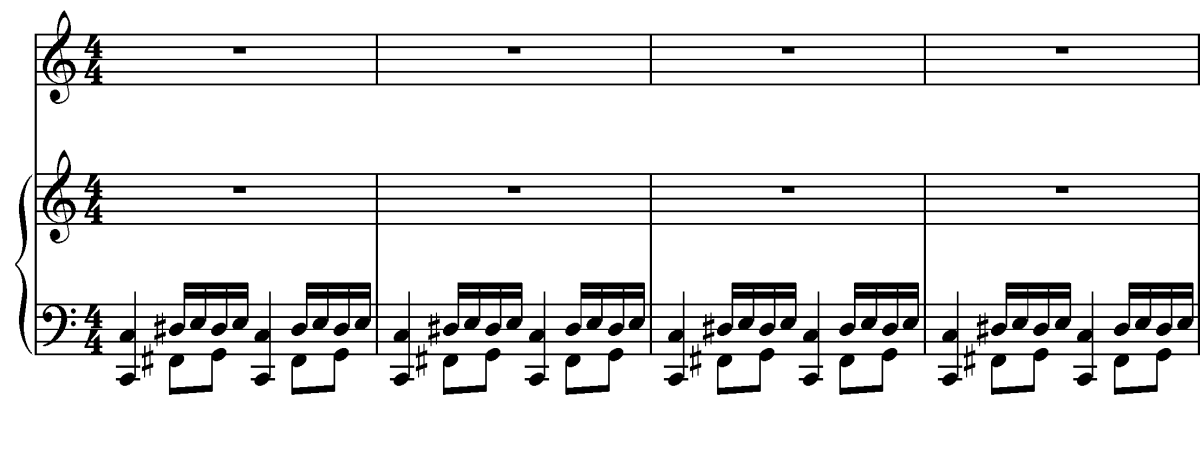
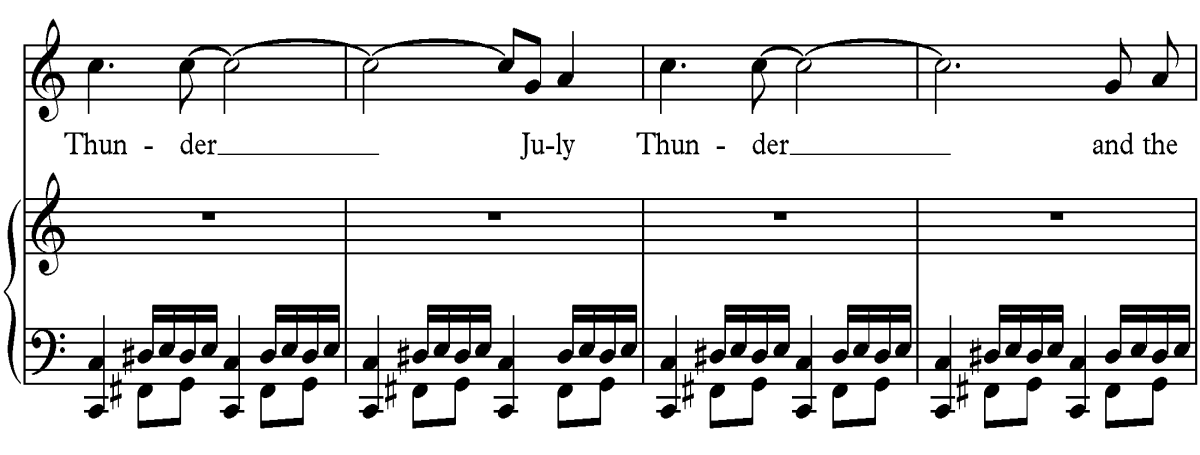
The second statement of the A section (not shown) begins in m. 21 with a two-bar piano interlude that is an exact repetition of the first two bars of the song. Slight variations occur in the melody and rhythms of the last nine measures of this section leading up to the transition into the B section that begins in m. 39 (not shown). The piano continues to emulate the storm with recurring eighth-notes (see Example 1.6) while the vocal line shifts from the long-sustained phrases of the A section to short, hurried declamatory phrases found throughout the B, C, and D sections of “Summer Storm.” These short declamatory phrases can be seen in Example 1.6 and Example 1.9. Similar to the second statement of the A section, the B section also begins with a two-bar piano interlude that leads up to the key signature change in m. 41 (see Example 1.6).
Ex. 1.6: “Summer Storm,” from Songs of the Seasons, mm. 41–42.
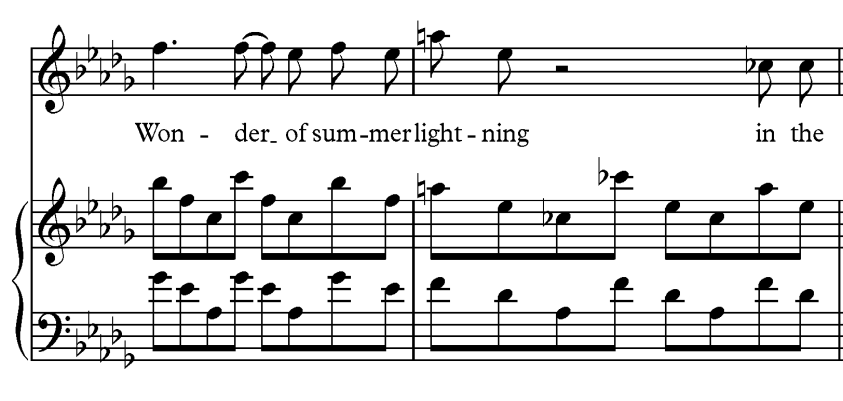
The music returns to the original tonality based on the blues scale in m. 45 where it remains until the beginning of the C section (minus a short four-bar excursion to A-flat major that begins in m. 49). The C section, beginning in m. 55, returns to the key signature of D-flat major and begins with a two-bar piano interlude that is an exact repetition of the piano music found in mm. 41–42 in Example 1.6. Again, the music returns to the modally inflected C major (blues scale) before the beginning of the D section that begins in m. 73, where one last modulation occurs. This time the music moves to the key signature of E-flat major where it remains until m. 83, just three bars before the final reprise of the A section. In m. 86 the thematic material from the prelude reappears (see Example 1.7). Here, the music returns to the blues major pentatonic scale for the final twenty-four bars of the song.
Ex. 1.7: “Summer Storm,” from Songs of the Seasons, mm. 86–90.

Bonds ended this piece on a C6 in the voice part sustained over four bars and provided an option for the singer to sing a G5, as seen in mm. 105–109 of Example 1.8. The range of this song is E4 to C6, making it most suitable for high voices. Mezzo-sopranos and baritones capable of handling a high tessitura may be able to sing this song due to the optional ending.
Ex. 1.8: “Summer Storm,” from Songs of the Seasons, mm. 105–109.
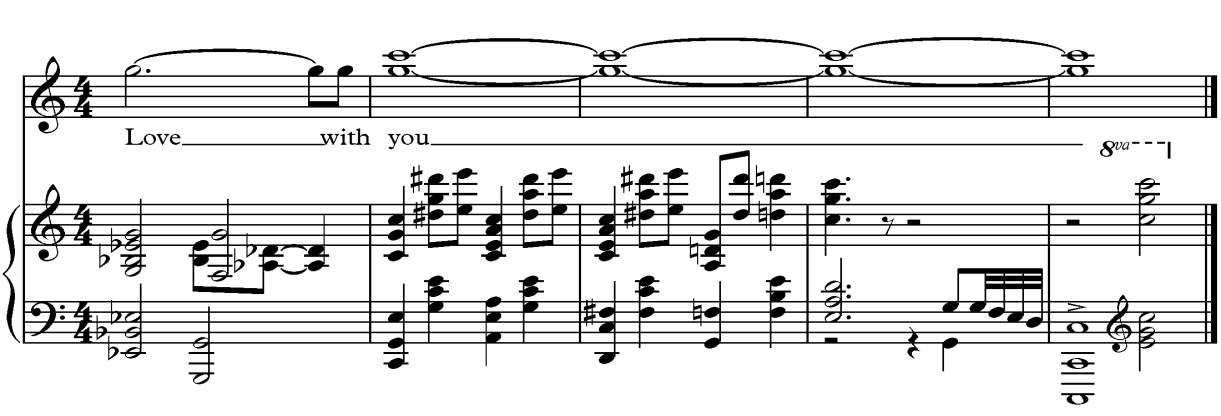
In “Summer Storm,” Bonds incorporated several examples of text painting. Three examples are shown; the first occurs in m. 42 in Example 1.6 on the word “lightning.” The second appears in m. 50 in Example 1.9 at “confetti drifting down.” Here, Bonds also used a descending chromatic scale in the middle voice of the piano to imitate the blossoms falling from the trees which Hughes described as “confetti drifting down” (see mm. 49–50 in Example 1.9). The third example appears in mm. 69–70 in Example 1.10 at “the soft sweet rain came down.” Bonds used a descending rhythmic figure to embellish the word “sweet” and a descending melody to illustrate the falling rain.
Ex. 1.9: “Summer Storm,” from Songs of the Seasons, mm. 48–50.
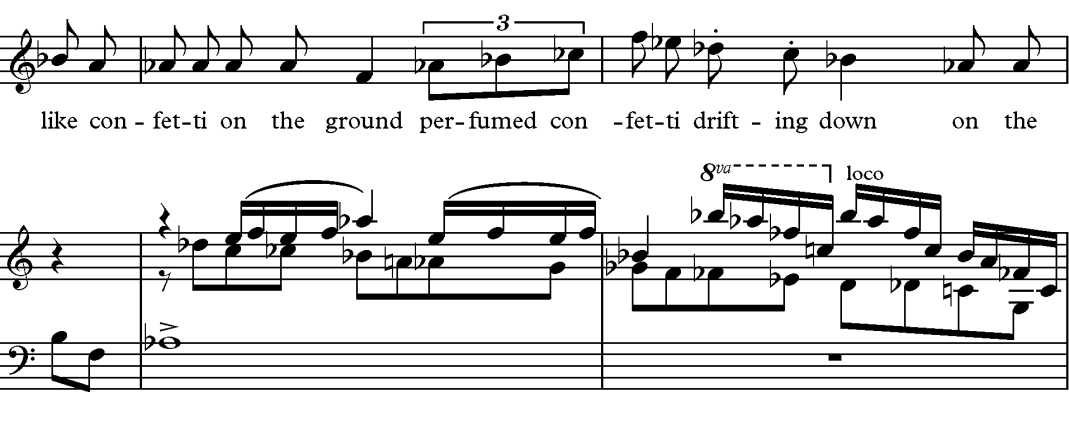
Ex. 1.10: “Summer Storm,” from Songs of the Seasons, mm. 68–70.
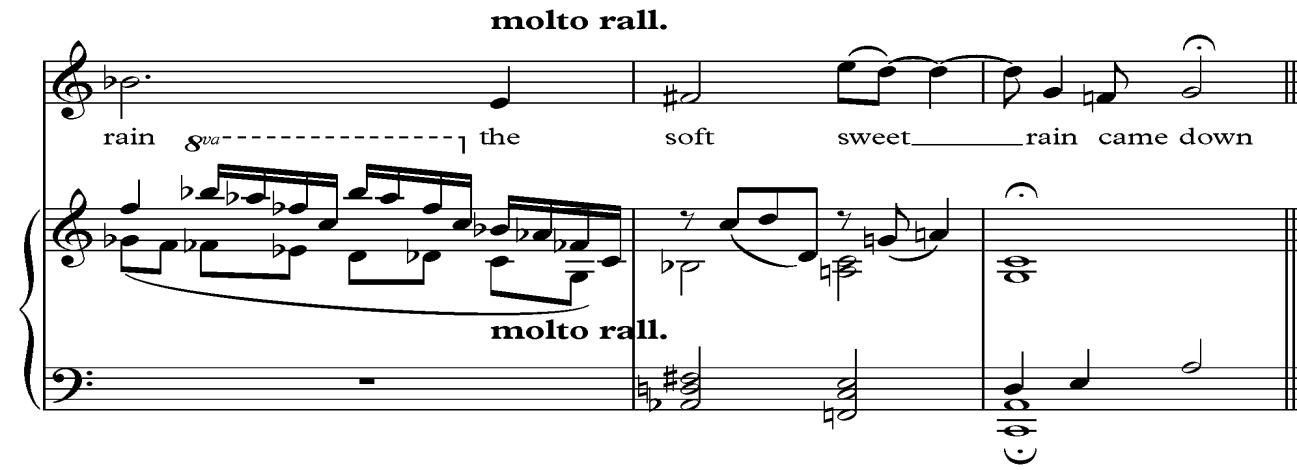
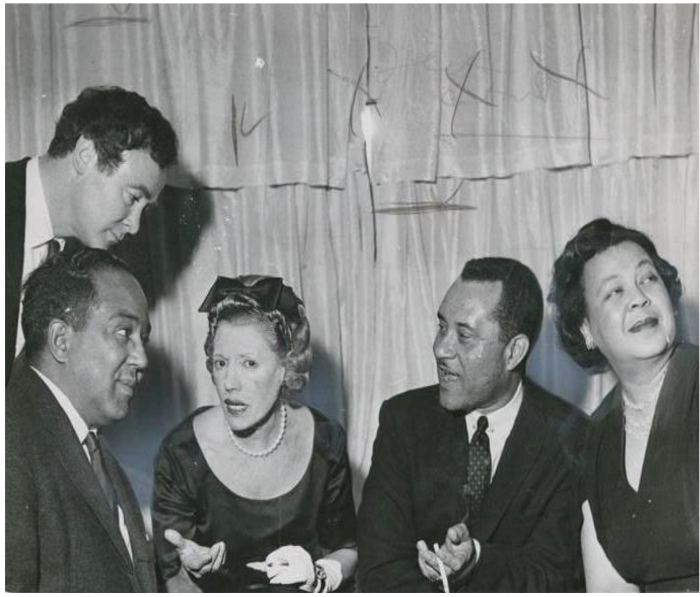
Figure 1.2: Author and playwright Langston Hughes, seated at the left, actress Helen Menken, seated second from left, pianist and composer Margaret Bonds, seated at right, and two unidentified men, attending unidentified theatrical event. (Clemons, Curt). [4]
Conclusion
Many of the art songs of Margaret Bonds have remained unpublished for decades. However, in early fall 2020, the following song anthology, Rediscovering Margaret Bonds: Art Songs, Spirituals, Musical Theater, and Popular Song, edited by Louise Toppin, will be available through Classical Vocal Reprints. This song anthology will include Songs of the Seasons as well as additional art songs with texts by Countee Cullen, Robert Frost, Langston Hughes, Robert Frost, Edna St. Vincent Millay, and Bonds herself. A comprehensive list of Margaret Allison Bonds’s solo vocal works can found in The Life and Solo Vocal Works of Margaret Allison Bonds (1913-1972) by Alethea Nadine Kilgore. [5]
[1] Constance Porter Uzelac, “Majors, Monroe Alpheus,” in Dictionary of American Negro Biography, ed. Logan Rayford and Michael Winston, (New York: W. W. Norton and Co., 1982), 421.[2] Drafts of Langston Hughes's poem "Ballad of Booker T.," 30 May-1 June. 30-31 May first and second drafts; 1 June 1, 1941. Manuscript/Mixed Material. https://www.loc.gov/item/mcc.024/.
[3] Recital program, “John Greene, Margaret Bonds, and Mary Catherine Collins’s Piano and Vocal Recital, April 15, 1934, Abraham Lincoln Centre,” Folder 2/2, Scrapbook, ca. 1931-1935, Series 19/3/6, Box No. 2, Emily Boettcher Bogue (1907-1992) Papers 1907-1996.
Photographs and Prints Division, Schomburg Center for Research in Black Culture, The New York Public Library, Astor, Lenox, and Tilden Foundations. Photography by Curt Clemons.
[5] Kilgore, Alethea N. “The Life And Solo Vocal Works Of Margaret Allison Bonds (1913-1972)”, 2013. http://purl.flvc.org/fsu/fd/FSU_migr_etd-8581.

Alethea N. Kilgore has worked as an Associate Professor of Vocal Studies at Florida A & M University since 2005. She holds a Bachelor of Music degree in vocal performance from the University of Cincinnati, College Conservatory of Music and a Master of Music and Doctor of Music degree in vocal performance from The Florida State University, College of Music.
Kilgore’s doctoral treatise, The Solo Vocal Works of Margaret Allison Bonds (1913-1972) serves as the only comprehensive publication to date, on the complete solo-vocal works of composer, Margaret Allison Bonds. March 2-3, 2013, Kilgore served as a lecturer and performer in the centennial celebration: A Symposium of Celebration: Margaret Allison Bonds (1913-1972) and the Women of Chicago, held on the campuses of University of North Carolina at Chapel Hill and North Carolina Central University, an event sponsored by Videmus.
Kilgore has sung leading and supporting roles in Carmen, Così fan tutte, Don Giovanni, Le nozze di Figaro, Eugene Onegin, Orphée aux Enfer, and Tales of Hoffmann. She is a member of National Association of Teachers of Singing and from 2016-2018 served as the President of the North Florida Chapter. Kilgore's goal is to continue serving others as an educator, performer, and researcher in the field of music.
-
03
-
03
-
03
-
03
-
03
-
03
-
03
-
03
-
03
-
03
-
03
-
03
-
03
-
03
-
03
-
03
-
03
-
-
-
03
-
03
-
03
-
03
-
03
-
03
-
03
-
03
-
-
03
-
03
-
03
-
03
-
03
-
-
03
-
03
-
03
-
03
-
-
03